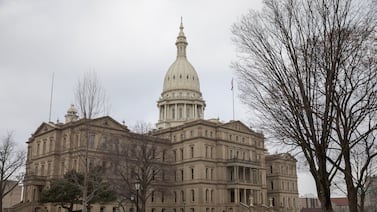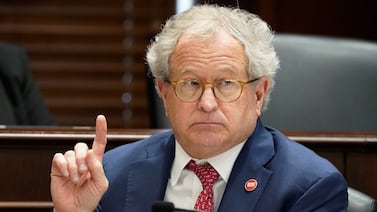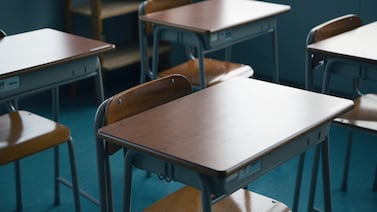Sign up for Chalkbeat New York’s free daily newsletter to get essential news about NYC’s public schools delivered to your inbox.
Fewer Black and Latino students were offered seats at New York City’s specialized high schools for this fall, potentially deepening segregation at some of the city’s most coveted campuses.
Just 3% of offers at eight of the city’s specialized schools went to Black students, down from 4.5% last school year, according to Education Department data released Thursday. Meanwhile, 6.9% of offers went to Latino students compared with 7.6% a year ago. Across the city’s public schools, nearly two-thirds of students are Black or Latino.
Asian American students received nearly 54% of the offers, a slight increase. The proportion of offers that went to white students, about 26%, was flat. Nearly 17% of public school students are Asian American and about 15% are white.
Specialized high schools command outsized attention because they are widely considered to be some of the most prestigious public schools in the country, even as they only enroll about 5% of the city’s public high school students. They also contribute to the city’s status as one of the nation’s most segregated school systems.
Admission to eight of the city’s nine specialized high schools depends entirely on a student’s score on a single standardized exam. Five of the eight specialized schools that rely on the Specialized High School Admissions Test, or SHSAT, admitted 10 or fewer Black students this year. Out of 781 offers to Stuyvesant High School, the most selective of the specialized schools, just 8 went to Black students.
Overall, nearly 26,000 eighth graders took the SHSAT, and 4,000 were offered a seat based on their score, according to the data.
On Friday, a day after department officials released the admissions data, spokesperson Jenna Lyle wrote in an email that “when our schools are segregated, students lose out on the incredible education that a richly diverse, inclusive environment carries.”
She noted that the city greenlit three new selective schools where most students are Black or Latino. And she pointed to an existing program that allows schools to set aside seats for students in underrepresented groups.
Lyle did not address questions about the timing of the release. For at least a decade, the Education Department has released the high school admissions statistics by mid-June, raising questions about whether officials delayed the release deeper into the summer to draw less attention to the issue. After Chalkbeat published a story on Thursday about the delay, officials released the data.
Education Department spokesperson Nicole Brownstein indicated on Thursday morning that the statistics were delayed because officials were waiting to verify new data. When asked what new data was included in the release that caused the delay, Brownstein pointed to a list of admissions deadlines.
The persistently low percentage of Black and Latino students who gain admission to the specialized high schools has fueled calls to scrap the test, which critics contend unfairly excludes many students who could thrive in those schools.
But the exam’s supporters argue that it is an objective assessment that does not factor in prior academic achievement and which levels the playing field for students who work hard to prepare. The majority of students admitted to the city’s specialized high schools are Asian American, many of whom come from immigrant and low-income families.
Before he was elected mayor, Eric Adams blasted the test-only admissions process and said officials were “tolerating a Jim Crow school system.” Since taking office, Adams hasn’t advanced any proposals to reform the admissions process at those schools, nor has he prioritized school integration policies more broadly.
“We’re seeing the story get worse, and I think this is indicative of the lack of approach this administration has taken to addressing segregation across the city and in the specialized high schools,” said Matt Gonzales, a longtime integration advocate and the campaign director of New Yorkers for Racially Just Public Schools. “It’s time for serious action on this.”
None of the major candidates running for mayor have proposed significant changes to the SHSAT, which would require approval from lawmakers in Albany. In 1971, the state legislature required the city to begin using a single test for admission at three specialized high schools (the city later designated five more test-only specialized schools).
Zohran Mamdani, the Democratic nominee for mayor and a graduate of Bronx Science, a specialized school, previously said he supports “an independent analysis of the Specialized HS exam for gender and racial bias.” He has not proposed any specific reforms.
Former Gov. Andrew Cuomo, who is running an independent campaign, supports using the SHSAT while expanding access to test preparation, an idea that has historically not moved the needle. Republican candidate Curtis Sliwa also supports the exam and wants to open more specialized schools.
Any proposal to overhaul admission to the coveted schools would likely invite intense backlash. The specialized schools are often seen as a springboard into top colleges, though studies have found that students with similar academic qualifications who attend different schools end up with similar SAT scores and college admissions offers.
Former Mayor Bill de Blasio proposed scrapping the exam in favor of a system that would automatically admit the top-performing students at each middle school, a reform that officials projected would dramatically increase Black and Latino enrollment. Still, the proposal would have sharply reduced offers to Asian American students, prompting fierce pushback from community leaders who argued they had not been included in shaping the policy.
Complicating matters, de Blasio’s proposal failed to gain traction in Albany, and lawmakers have brushed off other proposals to change the law.
City officials on Thursday also released statistics on admissions offers to programs outside the specialized schools.
Across roughly 72,000 eighth graders who received a high school admissions offer, 59% got their first choice, up from 51% last year. Officials said roughly the same proportion of middle schoolers were matched with their top choice as last year, or about 77%.
Unlike last year, city officials did not immediately release the overall demographics of students who were admitted to screened high schools other than the specialized schools. On Friday, officials released statistics that showed there have not been major demographic shifts on those campuses.
Editor’s note: This story has been updated with additional responses from the Education Department that were provided after this story was published.
Alex Zimmerman is a reporter for Chalkbeat New York, covering NYC public schools. Contact Alex atazimmerman@chalkbeat.org.






